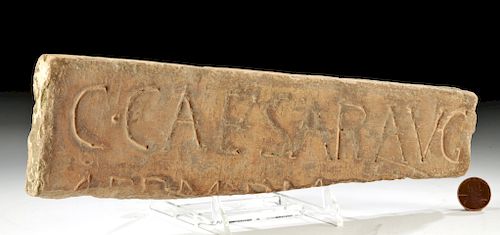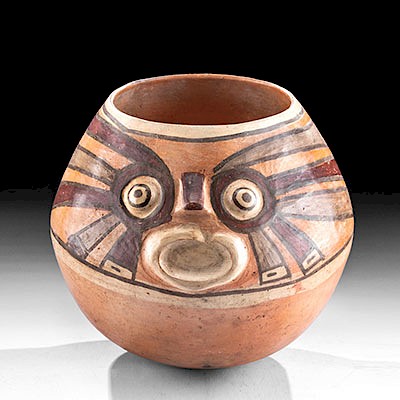Roman Terracotta Panel Fragment - Caesar Augustus
Lot 30
About Seller
Artemis Fine Arts
686 S Taylor Ave, Ste 106
Louisville, CO 80027
United States
Selling antiquities, ancient and ethnographic art online since 1993, Artemis Gallery specializes in Classical Antiquities (Egyptian, Greek, Roman, Near Eastern), Asian, Pre-Columbian, African / Tribal / Oceanographic art. Our extensive inventory includes pottery, stone, metal, wood, glass and textil...Read more
Categories
Estimate:
$2,500 - $3,500
Absentee vs Live bid
Two ways to bid:
- Leave a max absentee bid and the platform will bid on your behalf up to your maximum bid during the live auction.
- Bid live during the auction and your bids will be submitted real-time to the auctioneer.
Bid Increments
| Price | Bid Increment |
|---|---|
| $0 | $25 |
| $300 | $50 |
| $1,000 | $100 |
| $2,000 | $250 |
| $5,000 | $500 |
| $10,000 | $1,000 |
| $20,000 | $2,500 |
| $50,000 | $5,000 |
| $100,000 | $10,000 |
| $200,000 | $20,000 |
About Auction
By Artemis Fine Arts
Dec 5, 2019
Set Reminder
2019-12-05 10:00:00
2019-12-05 10:00:00
America/New_York
Bidsquare
Bidsquare : Ancient / Ethnographic - Holiday Edition
https://www.bidsquare.com/auctions/artemis-gallery/ancient-ethnographic---holiday-edition-4710
What to give this holiday season? Ancient & Ethnographic Art of course! Our special Holiday auction features hundreds of unique finds from all over the world. Artemis Fine Arts info@artemisfinearts.com
What to give this holiday season? Ancient & Ethnographic Art of course! Our special Holiday auction features hundreds of unique finds from all over the world. Artemis Fine Arts info@artemisfinearts.com
- Lot Description
Roman, early Imperial Period, reign of Caesar Augustus, ca. 27 BCE to 14 CE. A mold-formed fragment of a terracotta panel, of either dedicatory or mandatory significance, displaying the inscribed name "CAESAR AUG" along the top line. The name portrayed is an abbreviation of Caesar Augustus (also known as Octavian, born Gaius Octavius Thurinus), the first and arguably the most important emperor in the history of Imperial Rome. The smooth edges and peripheries of the fragment indicate that many copies of panels like this example were created for displaying in multiple well-trafficked areas of the city. Though the inscription is incomplete, one can only wonder what information was being dispersed! Lucite display stand for photography purposes only. Size: 9.9" L x 2.875" W (25.1 cm x 7.3 cm).
Caesar Augustus - his full title being "Imperator Caesar Divi Filius Augustus" - is considered by many to be not only the most important of all the Roman emperors but also the father and founder of the Roman Empire itself. After defeating the armies of Ptolemaic Egypt at the Battle of Actium, Octavian unified the Roman and Egyptian worlds and thus established the groundwork for moving Rome from the Republic period into that of the Imperial. His actions were bolstered through his implementation of a regulated annual system of taxation (as opposed to arbitrary taxation), a renewed respect for religion and traditional gods (many of which were adopted from ancient Greek deities), and the expansion of trading networks across Europe.
Provenance: private Keller collection, Alabama, USA; ex-private Toro collection, Spain, acquired in the 1940s
All items legal to buy/sell under U.S. Statute covering cultural patrimony Code 2600, CHAPTER 14, and are guaranteed to be as described or your money back.
A Certificate of Authenticity will accompany all winning bids.
We ship worldwide and handle all shipping in-house for your convenience.
#148803This is a fragment of a larger terracotta panel. Minor chips and abrasions to front, peripheries, and verso, with light softening to some inscribed letters, and light encrustations. Nice earthen deposits throughout.Condition
- Shipping Info
-
All shipping is handled in-house for your convenience. Your invoice from Artemis Gallery will include shipping calculation instructions. If in doubt, please inquire BEFORE bidding for estimated shipping costs for individual items.
-
- Buyer's Premium



 EUR
EUR CAD
CAD AUD
AUD GBP
GBP MXN
MXN HKD
HKD CNY
CNY MYR
MYR SEK
SEK SGD
SGD CHF
CHF THB
THB














